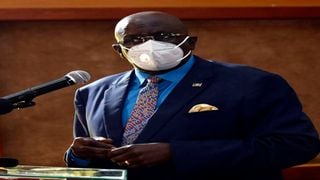
Education Cabinet Secretary Prof. George Magoha makes his remarks during a multi-sectoral agency briefing on October 27, 2021. According to a CBC report, Universities will be expected to invest more in (Stem) disciplines.
| Francis Nderitu | Nation Media GroupNews
Premium
How CBC will change university education
What you need to know:
- Majority of students currently studying at both private and public universities are undertaking courses in humanities and the arts
- Universities will be expected to invest more in Stem disciplines
- University programmes will be aligned to the CBC and will take three years, down from the current four
Universities will conduct a review of their programmes that will be expected to shift the balance from courses in humanities and arts to science, technology, engineering and mathematics (Stem) in preparation for roll-out of the competency-based curriculum (CBC).
According to the report of the Task force on Enhancing Access, Relevance, Transition, Equity and Quality for Effective Curriculum Reforms Implementation, the majority of students currently studying at both private and public universities are undertaking courses in humanities and the arts. This is in sharp contrast with the aspirations of the Basic Education Curriculum Framework (BECF) on which CBC is anchored.
Universities will be expected to invest more in Stem disciplines, because it is expected that about 60 per cent of students transitioning from senior secondary school will undertake the new pathway, creating new demand for the courses.
“The BECF has conceptualised senior secondary school as a level where specialisation begins, with learners making choices from a range of disciplines organised in pathways and tracks (individual subjects attached to it),” the report reads.
The BECF further envisages a 25 per cent enrolment in social sciences and 15 per cent in arts and sports science. University programmes will be aligned to the CBC and will take three years, down from the four under the current 8-4-4 system.
The task force, which was chaired by Prof Fatuma Chege, who was later appointed the principal secretary for Implementation of Curriculum Reforms, has recommended that the Commission for University Education “fast-tracks development and review of university programmes to align with the three pathways offered in senior secondary school”.
“Universities and the programmes they offer are expected to play a central role in the socio-economic transformation of the country as envisaged in the Kenya Vision 2030, which aspires to transform the country into a prosperous and internationally competitive nation,” the report reads.
According to data gathered by the task force, students taking courses in education (arts) account for 20 per cent of university enrolment at 110,433 students. This is closely followed by business administration at 19.9 per cent (106,544 students) and humanities and arts with 8.4 per cent (44, 779 students).
“It is noteworthy, however, that there is a relatively slow absorption of these students into gainful employment upon graduation but the programmes themselves are cheap to mount, as they do not require much capital investment in equipment,” the task force observed.
Law has the lowest enrolment at 8,950, which translates to 1.7 per cent, ICT has 27,037 students representing 5 per cent while agriculture, forestry, fisheries and veterinary medicine have 27,320 students, accounting for 5.1 per cent of the student population.
“Programmes with low enrolment are relatively expensive to mount as they require workshops, specialised equipment and tools as well as close supervision of students,” the report reads.
The BECF has been designed such that learners explore their potential, interests and personality traits in junior and senior secondary school. While all learners study all the compulsory subjects in junior school, they branch off to their preferred pathways in senior secondary. The pathways are arts and sports science, social sciences, or Stem.
If the recommendations of the task force will be adopted, all secondary schools will host both junior and secondary school. They will also host at least two pathways.
The ministry will then identify those that can host all three pathways based on their resources. These will most likely be the existing national schools and extra-county schools, which already have laboratories, workshops, music rooms and equipment and sports facilities. The task force has mapped the facilities available in schools and identified gaps that need fixing.
“Notably, there are only two institutions in Kakamega and Nairobi with facilities for visual and performing arts, thus indicating a gap for the development of talents in other tracks under the sports and arts pathway,” the task force noted.





